Introduction
Bagging and Boosting are two ensemble learning methods that enhance the system’s performance by combining several weak learners to get one active learner. The predicted output of each weak learner is connected using model averaging techniques to get the final result.
Overfitting in machine learning means a model does not perform as well with the new dataset as it did with the trained dataset. Bias and variance reduce the prediction rate and behavior of the model. Bagging and boosting can resolve overfitting, bias, and variance in machine learning.
“Bagging and Boosting: a key to enhance the accuracy rate of prediction in Machine Learning.”
Machine learning is a sub-part of Artificial Intelligence that gives power to models to learn on their own by using algorithms and models without being explicitly designed by developers. Machine Learning predicts the output and adds intelligence to the machine with AI concepts.
Bagging and Boosting are ensemble methods used interchangeably in Machine Learning to make a more accurate predicting model.
This post will describe the concepts of bagging and boosting with their fundamental differences, similarities, and an overview of ensemble methods in machine learning.
What is an Ensemble Method?
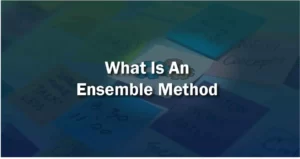
Ensemble methods are an essential method of Machine learning combining all weak learners to get one active learner. In ensemble learning, use one base algorithm to train the multiple models with the same datasets. Combining the predicted output of each model by using model averaging techniques like max voting, variance, etc.
This combination of several models increases the model’s accuracy as individual models are weak at predicting accurately.
There are two types of ensemble models: homogeneous model and heterogeneous model.
In the homogeneous model, all weak learners are trained homogeneously with the same base algorithms, while in the heterogeneous model, all weak learners with multiple base algorithms. This article will focus only on homogeneous models, bagging and boosting.
The two essential ensemble methods are
- Bagging: It is a homogeneous ensemble method, where learners parallel learns from each other and, in the end, predict the final result.
- Boosting: It is a homogeneous ensemble method where learners learn sequentially with each other.
Let’s explore Bagging and boosting more deeply. So, get ready to dive into this exciting topic of machine learning.
What is Bagging and Boosting?
Bagging and Boosting are based on the concept of dividing a task into small modules by working on each module and combining the output of all modules to get the final result.
Bagging
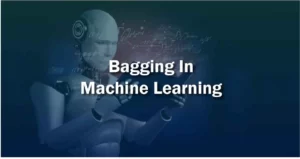
It is also known as Bootstrap Aggregating, which is a machine learning approach to reduce the variance and avoid overfitting, resulting in more accurate prediction by the learning models.
In Bagging, make multiple subsets by sampling and replacement methods from the training datasets. For the same data set, a model is used with a base algorithm, like a Decision Tree, to predict the output. Combining the production of all models using model averaging techniques like Random Forest to predict the outcome.
Use multiple datasets to train various models parallel and are generated randomly with replacements in the original input datasets.
In Bagging, the Decision tree approach is mainly used to predict a model’s behavior.
For example, the Random Forest Model uses Bagging Bagging; this model uses multiple decision trees to grow trees, resulting in a complete random forest.
Boosting
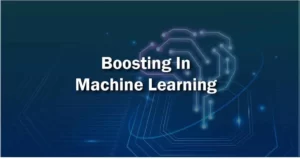
It is a sequential ensemble method to convert weak learners into strong learners by adjusting or increasing the weights of the observations (data points) on the model as per the last model.
In boosting, use the original dataset to train the first model; the second model tries to remove errors of the first model by training the second model with an increased weight of observations. The procedure continues sequentially until an accurate prediction or many models are covered.
A track of errors made by each learner is recorded and removes errors by increasing the weight of the observation with the following model.
Example: Addabooster, here boosting is used to reduce the error rate.
Working of Bagging
- Suppose there are M models, D is datasets, N is several data, and F is a data feature. In Bagging, all M models work parallel to each other.
- Dividing the dataset into test data & training data.
- The first model says m1 with the training data samples. In another modelm2, resample the training data and train it with another sample again, and resample the training data from another model. In this way, the whole process goes, and sometimes, we can have two or more duplicate training data records because we are sampling the dataset without adding or removing it. This process is called Raw Sampling with Replacement.
- Use the average model prediction method to calculate the final prediction by combining predictions of all models.
Advantages and Disadvantages of Bagging
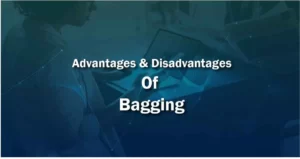
Advantages of Bagging
- Convert weak learners: An effective way to convert weak models into strong learners is by parallel processing.
- Reduce variance: It reduces the variance and overfitting, which helps make a more accurate learning model.
- Increase accuracy: It increases the accuracy of machine learning algorithms, which is helpful in regression and statistical classification.
Disadvantages of Bagging
- Underfitting: Sometimes, it can result in underfitting if they have not properly trained the model.
- Costly: Expensive in terms of using several models.
Working of Boosting
In Boosting, we take a dataset and suppose M learning models are working sequentially.
Suppose we have M models with D sample datasets.
The first model says M1 is trained with a few samples from the dataset and checks the learning process of M1, and afterward, trains it with complete datasets. Use the predicted error by M1 with the identical sample records to train M2 and so on.
This sequential process ends when we train all weak learners, or we make the best prediction by the end.
Advantages and Disadvantages of Boosting

Advantages of Boosting< /b>
- Effective in reducing the variance and solving the two-classification problem
- Handle missing data: Useful in handling missing data as several models are sequentially connected so they can resolve missing data.
Disadvantages of Boosting
- Complex: It is complex to handle all models’ working and increase the data’s weight from every error. Algorithms are complicated to run in real time.
- Dependency: Each successor model is dependent on the last model which may result in an error.
Similarities between Bagging and Boosting
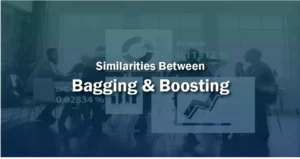
Listing all the similarities between Bagging and boosting:
- Ensemble method: Bagging and boosting are ensemble methods to convert weak learners into active learners.
- Variance reduction: Both work to address the problem of increased variance and overfitting.
- Generate datasets: Both randomly generate several datasets by sampling and some changes.
- Average predicted result: Both work to convert N learners into single learners and use the average model techniques to predict the outcome.
Differences between Bagging and Boosting
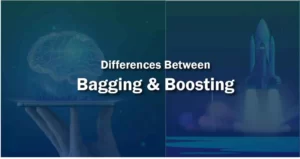
|
Boosting |
Bagging |
|
|
Dataset |
Use several datasets to train the models with some replacements in datasets. |
Every time increase the weight of the dataset to train the next learner. |
|
Issue |
It reduces bias in machine learning. |
It reduces variance and overfitting in machine learning. |
|
Order of working |
It is a sequential homogeneous model |
It is a parallel homogeneous model. |
|
When to use |
When the classifier has high bias and is straightforward. |
When the classifier has high variance and is not stable. |
|
Weights |
Increase observation weight on detecting error in prediction. |
Same weight on observation. |
|
Effects on weak model |
Every model is affected by the previously connected model. |
All models work independently. |
|
example |
AddaBoost |
Random Forest |
Which is better: Bagging or Boosting?
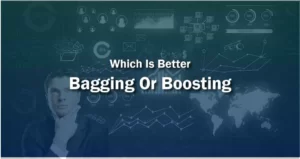
The answer lies in the requirement and problem to address. Both methods are best in their form and serve the best.
- Bagging is helpful when you want to reduce variance and overfitting of the model. Bagging makes more observations by using original datasets by sampling replacement methods in the data. Thus, models have more observations to train and increase prediction accuracy.
- Boosting is used when you want to reduce bias, generate more accurate results, and minimize prediction errors from past learning by increasing the weight on the observation for the coming model in sequential order.
As per my observations, bagging is better than boosting because it generates more datasets by sampling with replacement methods in the original datasets. Learners can feed with more input values resulting in accurate prediction.
Conclusion
We covered all the essential concepts of bagging and boosting in machine learning. The article described why bagging and boosting are necessary for individual working and their differences. Bagging and boosting are equally essential to maintain the model’s accuracy and convert weak learners into active learners. Dividing the Dataset into training & testing datasets. They use the training dataset to train the models and the testing dataset to test a model in a given circumstance and simulation.
Use both interchangeably to resolve the bias and variance of overfitting in machine learning. Both are best in their form with individual advantages, disadvantages, and similarities as both works on converting N learners into leaner. For Random Forest models, use bagging for decision tree classifiers and boosting for Adaboost.
Frequently Asked Question’s
1. What is the difference between bagging and boosting?
Bagging and boosting are ensemble methods in machine learning. Bagging a parallel learning process reduces the prediction variance or overfitting of the model. All N learners use the same dataset with resampling and replacement methods without changing the original dataset, resulting in multiple datasets to train the models.
Boosting is a sequential learning process that reduces the model’s prediction bias (variation between actual and predicted value) in machine learning. In Boosting, every successor model is dependent on the last model. Use the dataset with predicted error to train every coming model arranged sequentially. This is the main difference between bagging and boosting.
2. What is bagging and boosting in data science?
Bagging is a homogeneous ensemble learning method in machine learning used to reduce predicted variance or overfitting of the active model. N weak learners work in parallel to each other to convert into active learners. It uses the Decision tree classifier to predict the behavior of the model. Example: Random Forest uses bagging.
Boosting is a homogeneous ensemble learning method in machine learning that reduces the bias of the learning model. Bias is a difference between the actual prediction and the final prediction. In Boosting N, weak models working in sequence are converted into one robust model.
Use a trained dataset to train the first model, and the predicted error along with the dataset is used to train the second model until all models are covered, or we get a highly accurate prediction. Except for the first model, every next model depends on each other, increasing the error rate. Example AdaBooster.
3. What are bagging and boosting in ensemble learning?
Bagging is a method to convert several weak learners into strong learners. It uses a Decision tree classifier to get the prediction with reduced variance. Train all models with a training data set and combine each model’s prediction using the model averaging technique. It uses a base algorithm like a decision tree to train all models. Bagging values in the dataset are increased by sampling whenever training a model.
Boosting is an ensemble learning method in which N weak models are arranged in sequential order and trained with the same base algorithm. It reduces the prediction bias and enhances prediction accuracy by a machine learning model. Every model learns from its past model by training with error and increasing the weight of observations.
4. What is bagging and boosting in a random forest?
In random forest Bagging and Boosting, bagging is used in Random Forest with a Decision tree classifier to grow random trees. With a large number of random trees, it converts into a Random Forest.
Along with the observation, there is an additional feature of selecting random features instead of all features to grow trees.
Process:
- With the N number of observations in a dataset, there are M features to grow trees.
- Train each learner with resampling the data and features to get the prediction.
- All models work in parallel to each other. Use the best feature to split the decision tree node and grow the tree.
- The process continues with training all the models under given simulations.
5. What is the purpose of bagging?
The bagging aims to reduce variance and overfitting models in machine learning. Let me briefly define variance and overfitting.
Variance: The change in the model’s prediction when using a different dataset or variation in the input. The difference in the prediction compared to the actual prediction is called variance.
Overfitting: When the model fits more than the required data and tries to capture noise, other data is called overfitting.
Bagging converts N weak learners into active learners for more accurate predictions.
Boosting is used to reduce bias and increase prediction accuracy. Bias in machine learning is a deviation in actual and predicted values. A model performs well with training data, and showing different predictions with test data leads to bias. Bias reduces the prediction accuracy in machine learning.
Boosting is an ensemble learning method that helps to convert N weak models into strong ones using a sequential learning process. It also reduces the prediction error, and models learn from their last connected models.
7. Why is bagging better than boosting?
Both bagging and boosting are helpful to cover respective problems and are best. But bagging is better than boosting in two ways:
- Bagging can resolve overfitting that cannot be handled by boosting.
- Bagging generates more datasets from the original training dataset without any changes in the training dataset by resampling and replacement methods.
- In bagging, none of the weak models depends on the other model, as in Boosting.
8. Which one is faster, bagging or boosting?
It is challenging to compare bagging and boosting as both solve individual machine learning problems. But when it comes to overfitting, bagging can reduce overfitting, which affects the prediction of the model.
Boosting is best, as we have extra observations without changing the original training data.
In bagging, the same datasets with resampling are used to train the models, but in boosting with every error from the last model, observation weight is increased and trains the next model.
9. Can we combine bagging and boosting?
We can use Bagging and Boosting interchangeably to make more accurate model predictions in machine learning—a hybrid algorithm combining features of bagging and boosting to overcome both disadvantages. We can use the hybrid algorithms for Random Forest as the model learns from past errors.
10. What is a bagging technique?
Bagging is an ensemble method based on dividing a task into multiple sub-tasks. Here, several weak learners are combined parallel to get an active learner. All models are trained with a dataset by resampling the data and using the model averaging technique to connect the prediction of individual models to get a final prediction. We use a base algorithm like Decision tree classification to train the models.
Bagging reduces the variance and overfitting in machine learning and helps generate more accurate predictions.













